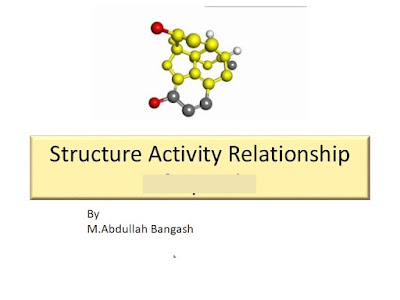Introduction to the topic:
Usually it
is obvious from the everyday science of experimentation that similar structures
produces the similar biological effect on the body. Taking a common example of Adrenaline and Nor
Adrenaline having almost same structures where N-Methylation of Nor-Adrenaline
give Adrenaline. Both have comparable activities usually by striking adrenergic
receptors.
Simply it is
said that structural Activity Relationships (SAR) are the relations between the
molecular structure and biological or physicochemical activity of the drugs.
The rational behind SAR is that chemical structure of a molecule determine its
physical and biological properties and its reactivity which in interaction with
biological system determine its biological and toxicological properties.
Or .The
Structure activity relationship (SAR) is a mean by which the effect of a drug
or toxic chemical on an animal, plant or the environment can be related to its
molecular structure. This type of relationship may be assessed by considering a
series of molecules and making gradual changes to them, noting the effect upon
their biological activity of each change.
Structure Activity Relationship
Structure
activity relationship studies are usually carried out by making minor changes
to a previously studied molecules which has some biological activity or the
lead (molecule having promising biological activity). By making changes the
potency, reactivity , affinity , and toxicological properties of the molecules
changes. As far as a drug is concerned, the weapons and armour are the various
chemical functional groups present in the structure, which can bind to the
receptor or enzyme. We have to be able to recognize these functional groups and
determine which ones are important.
The basic
assumption of SAR that “molecules having similar structure will have similar
activities” is some time exploited in a paradoxical manner. It is not the case
everywhere and for all type of assumptions. Sometime structure having similar
structures do not show correlation in their activity.
Changes which are done to produce the
analogues of a lead for Changing Activity
1) The size and shape of the carbon
skeleton.
2) The nature and degree of substitution.
3 3) The stereochemistry of the lead.
1) Changing the size and Shape of Carbon
Skeleton
Changing the
size include various changes like:
- · Changing the number of methylene groups in the chains or the rings.
- · Increasing or decreasing the unsaturation.
- · Introducing or removing the ring or cyclic structure.
- 1.1 Changing the number of Methylene Groups
1.2) Increasing or Decreasing the Unsaturation
Saturation
of double bond take the carbon atom to have single carbon-carbon bonding. Single
bond are more flexible and can easily fit in the receptor. But at the same time
removal of double bonding may loss the activity of the double bonding.
Introduction
of double bonding lead to rigid structures. And also may lead to E and Z
isomerization which may have different activities and some time same activity
with different potencies. For Example introduction of double bond at 1-2
position in cortisol form predison which is 30 times more potent then cortisol.
Usually the reactivity
of double bonding make the molecule to be more toxic and it is usually
undesirable to have double bond introduction. Further more double bond make the
structure more prone to metabolic oxidation.
1.3 Introduction or Removal of
Ring system
Introduction
or removal of ring system and its effect on activity is un-predictable. Introduction
of ring increase the size of the structure and may shape of the overall
structure. But for some target sites this increase in the structure fills the
hydrophobic pocket this increase the binding to the target.
For
example, it has been postulated that the increased inhibitory activity of the
cyclopentyl analogue (rolipram) of 3-(3,4-dimethoxyphenyl)-butyrolactam towards
cAMP phosphodiesterase is due to the cyclopentyl group filling a hydrophobic
pocket in the active site of the enzyme.
2) The nature and Degree of Substitution
Similar to
the introduction of the Ring introduction substitution is also somewhat
un-predictable. It may lead the molecule with different chemical and
pharmacokinetic properties. At the same time it may also affect the
lipophilicity of the drugs which may affect transport of the drugs. New group
introduction may introduce new pathways for metabolism. In nut shell
introduction of new substituent may cause lot of changes like increase or
decrease of potency, metabolic stability, duration of action and unwanted side
effects. Each substituent will impart
different characters to the lead.
3) Stereochemistry changes in SAR
Stereochemistry changes are usually done via phenomenon
of Isosteres and biosteres. Isosteres are the molecules or atoms having the
same number of outer shell electron, which lead them to have the same structure
usually. Majority of the lead,s analogues are introduced by preparing their
isosteres. 









I want this ppt send me plz..
ReplyDeletehaameem332@gmail.com
Haider Ali
Oh sorry for Late Replay will surely
DeletePlz send me this ppt....thanks
ReplyDeletehaameem332@gmail.com
HaiderAli